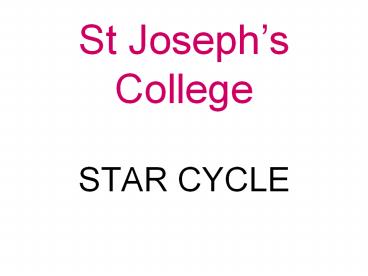St Josephs College - PowerPoint PPT Presentation
Title:
St Josephs College
Description:
St Joseph's College. STAR CYCLE. Our nearest star is the Sun. It is a small star known as a ... Thanks for watching Year 8 at St Joseph's College, London. ... – PowerPoint PPT presentation
Number of Views:76
Avg rating:3.0/5.0
Title: St Josephs College
1
St Josephs College
- STAR CYCLE
2
Our nearest star is the Sun.
- It is a small star known as a yellow dwarf and
its life span is 9 10 billion years.
The Sun is about half way through its life.
3
How do we know that stars are born, grow up, get
older and die?
- Imagine a visitor from space arrived on Earth and
saw
4
The alien could put them in order and work out
that a chicken starts life as an egg,
changes to a chick,
grows to be a chicken
5
and dies
6
Astronomers work in a similar way
They can see stars as they are being formed like
this picture of the Eagle Nebula
7
The dust and gas cloud collapses to form a star
which will last for a period of time depending on
its mass.
- Our Sun is a small star. Some nebulae are not big
enough to start shining when they collapse. They
are called brown dwarfs.
8
Some stars are huge up to 50 times the mass of
the Sun and 20 times its diameter.
- Stars cant be bigger than that because they give
out so much energy as they try to form that they
explode.
9
Stars give out light, heat and other radiation
into space but then die.
- The bigger the star, the shorter its life.
Dwarf stars like our Sun die quietly but bigger
stars make much more fuss!
10
A star produces energy by turning hydrogen into
helium in its core.
- When there is no hydrogen left nuclear fusion
stops and the star does not give out any more
radiation. Gravity takes over.
11
The core begins to collapse and energy is
released.
This is Betelgeuse A red giant .
- This makes the temperature and pressure in the
core rise and - heats up the outer atmosphere of the star.
You can see it in winter in a group of stars
called Orion
The star becomes up to 100 times bigger and gives
out red light. It has become a red giant.
Orion contains the Horsehead Nebula which you can
see with binoculars.
12
This is the Horsehead Nebula.
Its just below Orions belt.
13
Our Sun will get about 30 times bigger, eat
Mercury and Venus, burn off all the water on
Earth and make life here impossible.
- It will then shrink to become a white dwarf.
14
Massive stars die in Type II supernova explosions.
- These huge stars use up their hydrogen at a fast
rate they are gas guzzlers! Thy only last
thirty or so millions of years.
They become hundreds of times bigger than the Sun
and then the core starts collapsing when the
hydrogen runs out.
15
The collapse raises the temperature and turns the
helium into carbon and oxygen.
- The high temperature causes these to fuse into
neon, magnesium, silicon and sulphur and
eventually iron.
The star cant take any more and explodes as a
supernova.
16
Credits
- We used a book called Hubble - the mirror on
the universe by Robin Kerrod - and we used Google Images to find our pictures
which belong to NASA, Mark Garlick,Hubble
Telescope.
17
We hope you have enjoyed our brief look at the
birth, life and death of a star.
- Please dont worry about the Sun dying. It will
not happen for another 5 billion years!
Thanks for watching Year 8 at St Josephs
College, London.































